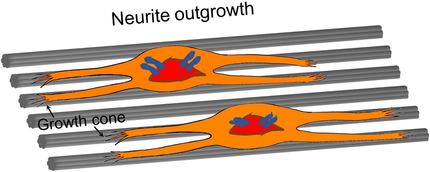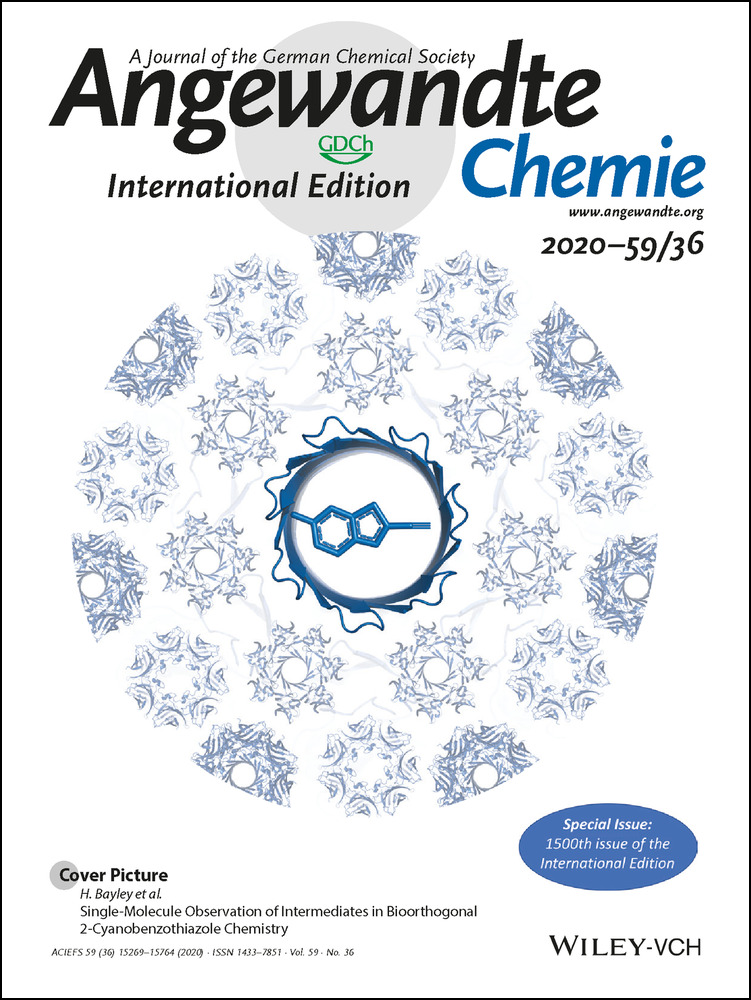Engraving the Surface of Electrospun Microfibers with Nanoscale Grooves Promotes the Outgrowth of Neurites and the Migration of Schwann Cells
Dr. Tong Wu
The Wallace H. Coulter Department of Biomedical Engineering, Georgia Institute of Technology and Emory University, Atlanta, GA, 30332 USA
Search for more papers by this authorDr. Jiajia Xue
The Wallace H. Coulter Department of Biomedical Engineering, Georgia Institute of Technology and Emory University, Atlanta, GA, 30332 USA
Search for more papers by this authorCorresponding Author
Prof. Dr. Younan Xia
The Wallace H. Coulter Department of Biomedical Engineering, Georgia Institute of Technology and Emory University, Atlanta, GA, 30332 USA
School of Chemistry and Biochemistry, School of Chemical and Biomolecular Engineering, Georgia Institute of Technology, Atlanta, GA, 30332 USA
Search for more papers by this authorDr. Tong Wu
The Wallace H. Coulter Department of Biomedical Engineering, Georgia Institute of Technology and Emory University, Atlanta, GA, 30332 USA
Search for more papers by this authorDr. Jiajia Xue
The Wallace H. Coulter Department of Biomedical Engineering, Georgia Institute of Technology and Emory University, Atlanta, GA, 30332 USA
Search for more papers by this authorCorresponding Author
Prof. Dr. Younan Xia
The Wallace H. Coulter Department of Biomedical Engineering, Georgia Institute of Technology and Emory University, Atlanta, GA, 30332 USA
School of Chemistry and Biochemistry, School of Chemical and Biomolecular Engineering, Georgia Institute of Technology, Atlanta, GA, 30332 USA
Search for more papers by this authorGraphical Abstract
Abstract
We report a simple method based upon coaxial electrospinning for the fabrication of aligned microfibers engraved with nanoscale grooves to promote neurite outgrowth and cell migration. The success of this method relies on the immiscibility between poly(ϵ-caprolactone) (PCL) and poly(vinyl pyrrolidone) (PVP) in 2,2,2-trifluoroethanol (TFE) for the generation of PVP/TFE pockets on the surface of a PCL jet. The pockets are stretched and elongated along with the jet, eventually resulting in the formation of nanoscale grooves upon the removal of PVP. The presence of nanoscale grooves greatly enhances the outgrowth of neurites from both PC12 cells and chick embryonic dorsal root ganglia (DRG) bodies, as well as the migration of Schwann cells. The enhancements can be maximized by optimizing the dimensions of the grooves for potential use in applications involving neurite extension and wound closure.
Conflict of interest
The authors declare no conflict of interest.
Supporting Information
As a service to our authors and readers, this journal provides supporting information supplied by the authors. Such materials are peer reviewed and may be re-organized for online delivery, but are not copy-edited or typeset. Technical support issues arising from supporting information (other than missing files) should be addressed to the authors.
| Filename | Description |
|---|---|
| anie202002593-sup-0001-misc_information.pdf1.9 MB | Supplementary |
Please note: The publisher is not responsible for the content or functionality of any supporting information supplied by the authors. Any queries (other than missing content) should be directed to the corresponding author for the article.
References
- 1I. Tonazzini, E. Jacchetti, S. Meucci, F. Beltram, M. Cecchini, Adv. Healthcare Mater. 2015, 4, 1849.
- 2D. Zhang, S. Wu, J. Feng, Y. Duan, D. Xing, C. Gao, Acta Biomater. 2018, 74, 143.
- 3B. Sun, T. Wu, J. Wang, D. Li, J. Wang, Q. Gao, M. A. Bhutto, H. El-Hamshary, S. S. Al-Deyab, X. Mo, J. Mater. Chem. B 2016, 4, 6670.
- 4M. R. Abidian, J. M. Corey, D. R. Kipke, D. C. Martin, Small 2010, 6, 421.
- 5J. Xie, M. R. MacEwan, X. Li, S. E. Sakiyama-Elbert, Y. Xia, ACS Nano 2009, 3, 1151.
- 6J. Xie, W. Liu, M. R. MacEwan, P. C. Bridgman, Y. Xia, ACS Nano 2014, 8, 1878.
- 7J. Xue, T. Wu, J. Li, C. Zhu, Y. Xia, Angew. Chem. Int. Ed. 2019, 58, 3948; Angew. Chem. 2019, 131, 3988.
- 8X. Li, M. R. Macewan, J. Xie, D. Siewe, X. Yuan, Y. Xia, Adv. Funct. Mater. 2010, 20, 1632.
- 9C. Leclech, M. Renner, C. Villard, C. Metin, Biomaterials 2019, 214, 119194.
- 10J. Seo, J. Kim, S. Joo, J. Y. Choi, K. Kang, W. K. Cho, I. S. Choi, Small 2018, 14, 1801763.
- 11S. H. Lee, H. B. Lee, Y. Kim, J. R. Jeong, M. H. Lee, K. Kang, Nano Lett. 2018, 18, 7421.
- 12E. Kang, Y. Y. Choi, S. K. Chae, J. H. Moon, J. Y. Chang, S. H. Lee, Adv. Mater. 2012, 24, 4271.
- 13R. A. Koppes, S. Park, T. Hood, X. Jia, N. Abdolrahim Poorheravi, A. H. Achyuta, Y. Fink, P. Anikeeva, Biomaterials 2016, 81, 27.
- 14Y. Chen, M. B. Taskin, Z. Zhang, Y. Su, X. Han, M. Chen, Biomater. Sci. 2019, 7, 2165.
- 15J. He, C. Sun, Z. Gu, Y. Yang, M. Gu, C. Xue, Z. Xie, H. Ren, Y. Wang, Y. Liu, M. Liu, F. Ding, K. W. Leong, X. Gu, ACS Nano 2018, 12, 9660.
- 16R. Viktorija, B. Ana, D. Petar, B. Dries, K. Damir, J. Neural Eng. 2019, 16, 066037.
- 17P. K. Mattila, P. Lappalainen, Nat. Rev. Mol. Cell Biol. 2008, 9, 446.
- 18K. Kang, S. Y. Yoon, S. E. Choi, M. H. Kim, M. Park, Y. Nam, J. S. Lee, I. S. Choi, Angew. Chem. Int. Ed. 2014, 53, 6075; Angew. Chem. 2014, 126, 6189.
- 19L. Zhang, S. Chen, R. Liang, Y. Chen, S. Li, S. Li, Z. Sun, Y. Wang, G. Li, A. Ming, Y. Yang, J. Biomed. Mater. Res. Part A 2018, 106, 3123.
- 20C. Huang, Y. Ouyang, H. Niu, N. He, Q. Ke, X. Jin, D. Li, J. Fang, W. Liu, C. Fan, T. Lin, ACS Appl. Mater. Interfaces 2015, 7, 7189.
- 21C. Simitzi, A. Ranella, E. Stratakis, Acta Biomater. 2017, 51, 21.
- 22A. Omidinia-Anarkoli, R. Rimal, Y. Chandorkar, D. B. Gehlen, J. C. Rose, K. Rahimi, T. Haraszti, L. De Laporte, ACS Appl. Mater. Interfaces 2019, 11, 7671.
- 23C. Huang, Y. Tang, X. Liu, A. Sutti, Q. Ke, X. Mo, X. Wang, Y. Morsi, T. Lin, Soft Matter 2011, 7, 10812.
- 24W. Liu, C. Huang, X. Jin, Nanoscale Res. Lett. 2015, 10, 237.
- 25I. Jun, Y. W. Chung, Y. H. Heo, H. S. Han, J. Park, H. Jeong, H. Lee, Y. B. Lee, Y. C. Kim, H. K. Seok, H. Shin, H. Jeon, ACS Appl. Mater. Interfaces 2016, 8, 3407.
- 26A. Greiner, J. H. Wendorff, Angew. Chem. Int. Ed. 2007, 46, 5670; Angew. Chem. 2007, 119, 5770.
- 27K. Kang, S. E. Choi, H. S. Jang, W. K. Cho, Y. Nam, I. S. Choi, J. S. Lee, Angew. Chem. Int. Ed. 2012, 51, 2855; Angew. Chem. 2012, 124, 2909.
- 28J. Xue, J. Yang, D. M. O'Connor, C. Zhu, D. Huo, N. M. Boulis, Y. Xia, ACS Appl. Mater. Interfaces 2017, 9, 12299.
- 29K. Yang, K. Jung, E. Ko, J. Kim, K. I. Park, J. Kim, S. W. Cho, ACS Appl. Mater. Interfaces 2013, 5, 10529.
- 30C. H. Chen, C. C. Tsai, P. T. Wu, I. K. Wang, J. Yu, W. B. Tsai, ACS Appl. Bio Mater. 2019, 2, 205.
- 31K. Yang, S. J. Yu, J. S. Lee, H. R. Lee, G. E. Chang, J. Seo, T. Lee, E. Cheong, S. G. Im, S. W. Cho, Nanoscale 2017, 9, 18737.
- 32C. M. M. Motta, K. J. Endres, C. Wesdemiotis, R. K. Willits, M. L. Becker, Biomaterials 2019, 218, 119335.
- 33C. Simitzi, P. Efstathopoulos, A. Kourgiantaki, A. Ranella, I. Charalampopoulos, C. Fotakis, I. Athanassakis, E. Stratakis, A. Gravanis, Biomaterials 2015, 67, 115.
- 34C. Masciullo, R. Dell'Anna, I. Tonazzini, R. Boettger, G. Pepponi, M. Cecchini, Nanoscale 2017, 9, 14861.
- 35B. B. Patel, F. Sharifi, D. P. Stroud, R. Montazami, N. N. Hashemi, D. S. Sakaguchi, Macromol. Biosci. 2019, 19, 1800236.
- 36R. Mayor, S. Etienne-Manneville, Nat. Rev. Mol. Cell Biol. 2016, 17, 97.
- 37C. Rosello, P. Ballet, E. Planus, P. Tracqui, Acta Biotheor. 2004, 52, 343.
- 38A. Béduer, C. Vieu, F. Arnauduc, J. C. Sol, I. Loubinoux, L. Vaysse, Biomaterials 2012, 33, 504.
- 39A. Sørensen, T. Alekseeva, K. Katechia, M. Robertson, M. O. Riehle, S. C. Barnett, Biomaterials 2007, 28, 5498.
- 40T. Wu, J. Xue, H. Li, C. Zhu, X. Mo, Y. Xia, ACS Appl. Mater. Interfaces 2018, 10, 8536.
- 41M. L. Tanes, J. Xue, Y. Xia, J. Mater. Chem. B 2017, 5, 5580.





